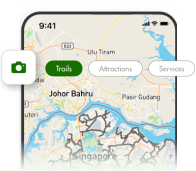
Government agencies communicate via .gov.sg websites (e.g. go.gov.sg/open). Trusted websites

Look for a lock (
Coastal and marine ecosystems
Singapore's coastal and marine ecosystems include diverse habitats such as mangroves, coral reefs and intertidal zones.
These habitats support a variety of life forms and are crucial in environmental health, from coastal protection to providing nurseries for marine species.
Despite their importance, these habitats face challenges due to urbanization and other pressures. NParks' Coastal and Marine Branch works towards efforts to conserve and manage these ecosystems.
Find out more about each habitat:
Mangroves

Mangrove forests are among the world's most productive wetlands, providing resources such as food, fiber and medicine, and offering protection to coastlines by mitigating the impact of sea waves during storm surges. These ecosystems also serve as food sources and nurseries for fish species that are vital to local fisheries.
In Singapore, mangroves are under threat from urbanisation and human population growth, with less than 5% of the original habitat from the 1800s still remaining today. The largest mangrove area on the mainland, Sungei Buloh Wetland Reserve, covers 130 hectares. It is legally protected and recognised as a site of international importance for migratory birds.
Conservation efforts by NParks include research collaborations to better understand and protect these vulnerable areas. Past studies have focused on topics such as the role of mangrove insects as indicators of habitat quality, impact of marine navigation and chemical contaminants on mangroves, and the dispersal of mangrove propagules (seeds of mangrove trees that can germinate while attached to the parent tree or after falling into water or soil).
NParks uses nature-based methods to protect and restore coastal areas.
Such efforts have been done to protect the coast and mangroves in Pulau Tekong as well as Kranji Coastal Nature Park.
Highlights of the Kranji Coastal Nature Park project include:
- Preserving existing mangroves.
- Solutions that were tailored to the area's unique environmental features, focusing on greening, flood-resistant design and enhancing ecosystems to improve climate resilience.
- Eco-engineering solutions that aim to encourage sediment build-up and natural mangrove regeneration, guided by advanced modelling techniques from the National Biodiversity Centre.
- Installation of a 400-metre-long low rock barrier. This barrier reduces wave energy, helps sediments to settle, and supports the natural growth of mangroves.
Restoration of a 0.49-hectare coastal vegetation belt that mirrors the natural progression from inland terrestrial forests to coastal and mangrove forests. This belt provides new habitats for wildlife and acts as a buffer against rising sea levels and storm surges.
Coral reefs

Singapore's coral reefs, located mainly around the southern islands, support a rich diversity of marine life . These reefs are home to over 250 species of hard corals, more than 200 species of sponges, 120 species of reef fish and various other marine organisms.
Each reef is divided into zones – the reef flat, reef crest, and reef slope – each supporting different marine communities based on depth and light availability.
- The reef flat, closest to the shore, is exposed during low tides and may vary in width and depth.
- The reef crest, which remains submerged, has the highest density of marine life.
- As one descends into the reef slope, the density of organisms decreases, and the community changes to those that are adapted to low-light conditions.
The sea floor is usually silty or sandy, but where rocky surfaces appear, are usually festooned with sea whips and sea fans and colourful cave corals.
These reefs are unique to Singapore and are an important part of the nation's natural heritage.
Intertidal zones
The intertidal zone, located between the highest and lowest tidemarks, is rich in marine life. It is one of the most stressful environments for marine creatures to live in as they are exposed to the air twice a day.
This zone includes habitats such as rocky shores, sandy beaches and seagrass meadows.
Rocky shores

Characterised by solid rocks and boulders, these areas support species such as the Pacific turban snail (Turbo bruneus), which is commonly found attached to rocks, and bristleworms and reef worms, which can be seen burrowing in the sand or under rocks. The Labrador Nature Reserve hosts 300m of rocky shore, the last on Singapore's mainland.
Sandy beaches

These beaches are not devoid of life. You can find burrowing animals such as sand bubbler crabs and ghost crabs, as well as sea stars, sand dollars and button snails among other wildlife. These creatures sift through the sand for food, playing vital roles in the ecosystem.
Seagrass meadows

Seagrasses are important for marine biodiversity and rich in biodiversity. They provide food and nursery grounds for juveniles of animals such as crabs, shrimps and fishes. Singapore has 12 species of seagrasses, found on both the northern and southern shores. Animals that can be found in seagrass habitats include sea stars, sea horses, crabs, sea urchins, sea cucumbers and snails.
Seagrass locations include Chek Jawa, Pulau Semakau, Cyrene Reef, Sentosa, Labrador Beach and Tuas. TeamSeagrass, a group of volunteers, conduct regular seagrass monitoring at these locations. Find out more about TeamSeagrass' work.
Intertidal etiquette
As the intertidal area is fragile, visitors should avoid touching, trampling or collecting wildlife. They should also wear covered shoes for protection. Find out more about intertidal dos and don'ts.
Support our conservation efforts
Find out more about our conservation efforts and support us through the Garden City Fund

 Mangroves
Mangroves Coral reefs
Coral reefs Intertidal zones
Intertidal zones

